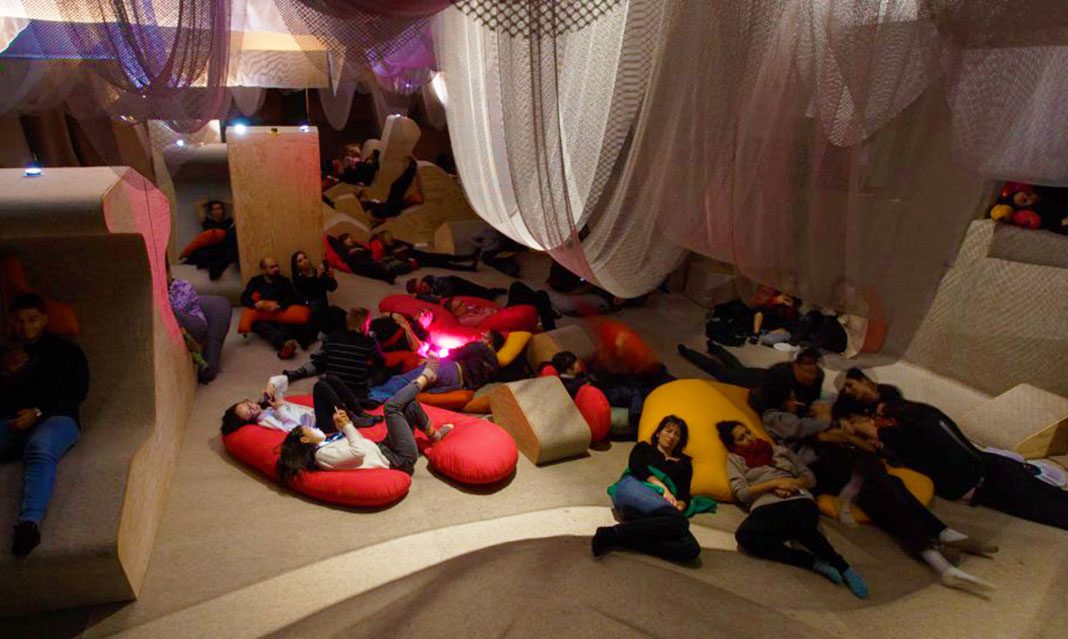University of Toronto’s John H. Daniels Faculty of Architecture, Landscape and Design’s exhibition New Circadia is a dreamlike escape. The exhibition’s concept was curated by Richard Sommer, Natalie Fizer, Emily Stevenson, and Laura Miller. The exhibit is featured in the Architecture and Design Gallery at the St. George campus.
New Circadia was inspired by the Mammoth Cave experiment of 1938, conducted by Dr. Nathaniel Kleitman. The scientific research explored the cycles of human sleep and wakefulness.
Part of the New Circadia exhibit was a gallery of educational artwork titled Circadian Rhythms and the Cycles of Daily Life. Clocks were hung on the walls which sectioned out the times of day different groups of people spend doing a specific task.
For instance, there was a section titled “Prayer time” which featured four religious groups: Islam, Christianity, Judaism, and Sikh. Each religious group had two clocks which illustrated the times of day that were devoted to prayer; one clock for summer and one for winter. Under the clocks was a legend and written description about how the religious groups divide their prayers.
Upon entering the New Circadia exhibition, the gallery instructed that no shoes may be worn, no photography, no consumption of food or drinks, and no pets are granted in the exhibit.
Before entering the metaphorical cave, a wall filled with cushions of various shapes, sizes, and colours were available for public use. Participants had the choice to take a pillow and use it in the cave.
To enter the exhibition, participants walk through a make-shift door, of thick grey felt fabric, and immediately are immersed into the metaphorical cave of New Circadia.
The lighting was dim, the floor was a soft carpet, and there were mesh fabrics drooping down from the ceiling. An artificial skylight mimicking the stars of a dark night. Periodically, soft sounds were heard—it sounded like a celestial white noise.
The exhibition was filled with abstract couch-like chairs. Those chairs had soft swoops which adhere to different positions a body may lay. The purpose of its abstract shape was to resemble the curves and uneven surface of caves. Part of the chairs where people could lay on were covered in a soft carpet fabric. Participants were invited to lay on these abstract chairs and relax in any way they wish.
The exhibit had various architectural features. Participants were free to climb the high ledges, which resembled massive sofas. There were also smaller semi-circled areas that were a bit more private for a singular person or couple to relax in.
New Circadia was a place of relaxation. The goal of the exhibition was to create a dreamlike space by snuggling the body and calming the mind. As I walked around, I felt like I was in a dream. The exhibit wanted to showcase that being in a state of rest is not unproductive, but rather essentially for human survival.
Inside the exhibit, participants were free to relax in any way they want by either sleeping, dreaming, or mediating—the exhibition was a safe-place for comfort. Conveniently, New Circadia is located at the St. George campus so students can enter the gallery to escape the stresses of school.
The exhibition also featured two stations regarding dreams. One included headphones where participants can listen to dreams. The other was a website which recorded dreams virtually.
The atmosphere of New Circadia was one I’ve never experienced before. It was a place of comfort, mediation, focus, and relaxation—a judge-free zone. Each person inside the exhibition kept to themselves and did not bother other participants.
If you’re interested in engaging in an exhibition that resembles a dreamlike state, visit New Circadia, for free, running until April 30.



